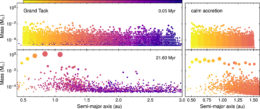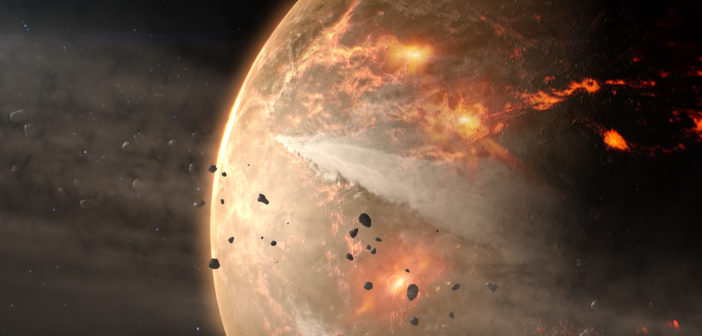Earth’s crust contains chemical elements that we’d expect to find in its core, not near its surface. What can detailed simulations of planet formation tell us about the likely origins of these elements?
A Crash Course in Earth History

A plot of the abundances of individual chemical elements in Earth’s crust. The siderophile elements, outlined in yellow, are rare in Earth’s crust, though not as rare as expected. [Gordon B. Haxel, Sara Boore, and Susan Mayfield from USGS]
The number, size, origin, and composition of the objects that delivered this final sprinkling of siderophile elements is still uncertain, though. Now, astronomers have used simulations to make sense of the elements found in Earth’s crust and reconstruct our home planet’s formation history.

Location, masses, and origins of planetesimals in the Grand Tack simulation (left) and the calm accretion simulation (right). The top row shows the beginning of the simulation and the bottom row shows the end. In the calm accretion scenario, the planetesimals tend to contain material sourced from their location (indicated by the symbol color). In the Grand Tack model, the planetesimals tend to become “bluer” because of material moved inward by Jupiter. Click to enlarge. [Adapted from Carter & Stewart 2022]
Plentiful Planetesimals
Philip Carter (University of Bristol, UK, and University of California, Davis) and Sarah Stewart (University of California, Davis) set out to understand if Earth’s unusual crustal composition could be due to collisions with planetesimals late in the planet’s formation history. To do so, the team used numerical models to track the composition of tens of thousands of simulated planetesimals as they migrated and collided over a period of 21 million years. The authors explored two scenarios for the dynamics of the inner solar system: the Grand Tack model, in which a simulated Jupiter barrels into the inner solar system before retreating to its current location, and the calm accretion model, in which there is no disturbance from a giant planet.
In the calm accretion model, planetesimals tended to collect material from very close to their birthplace. Since the composition of the planet-forming disk changes as a function of distance from the Sun, this means that planetesimals forming at different distances from the Sun had different compositions.
In the Grand Tack model, on the other hand, Jupiter’s migration mixes the material in the inner solar system, leading to the formation of planetesimals containing a blend of material from throughout the inner solar system. In this scenario, planetesimals at a range of distances from the Sun had similar compositions.
Ample Earth-Like Material

The Grand Tack model concentrates mass in a region located 0.8–1.3 au from the Sun. The Jupiter-induced mixing in this region results in a substantial fraction of planetesimals with similar composition to the planetary embryos that are present within 0.2 au. [Adapted from Carter & Stewart 2022]
This scenario could also explain why the Moon has the same chemical signature as Earth; if the Mars-sized protoplanet hypothesized to have collided with Earth to form the Moon contained elements in similar ratios to Earth, that would naturally explain the Moon’s composition.
Plenty of questions remain, but the new simulations make a compelling case that collisions between early Earth and material similar in composition could explain many aspects of present-day Earth. For more details and future prospects, be sure to read the full article cited below!
Citation
“Did Earth Eat Its Leftovers? Impact Ejecta as a Component of the Late Veneer,” Philip J. Carter and Sarah T. Stewart 2022 Planet. Sci. J. 3 83. doi:10.3847/PSJ/ac6095
